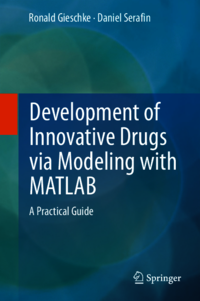Development of Innovative Drugs via Modeling with MATLAB
82 Visitas | 102 Descargas | 2015-01-07 16:57:21 | raulito
Descripción
bout 20 years ago, the pharmaceutical industry started to consider mathematical model-based drug development as a means to streamline the execution of drug development programs. This constituted a new discipline, pharmacometrics, grounded in pharmacology and statistics. We have written this book to describe our learning and experiences in the emergent field of pharmacometrics applied to drug discovery and clinical devel- opment. We did not aim to compete with the many excellent contributions in this field, both theoretical and practical, but rather wanted to highlight specific areas that we have repeatedly encountered. This book may also give answers to those who wonder to what kind of problems mathematics is actually applied in the modeling and simulation department of a large pharmaceutical company. Parts of this book require some familiarity with mathematical notation and elementary calculus including the concept of a differential equation. Besides providing some concepts behind drug discovery and development, we have added many exercises (with our solutions) designed to be solved symboli- cally or programmatically. As a programming language, we chose MATLAB (Version 2012b) as we found it best suited to the diversity of problems we faced. Our final message is that pharmacometrics could have an even larger impact on drug discovery and development if it were consistently applied to diseases and their potential treatment targets, thus merging with another quantitative discipline, systems biology, to form quantitative systems pharmacology. The book is organized into nine chapters. Background of Pharmacologic Modeling ( Chap. 1 ) introduces two topics which underpin later chapters: the emergence, role, and tasks of the pharmaceutical industry as a healthcare provider; and the philosophy of modeling and simulation. Regarding modeling, we start with a First Example of a Computational Model ( Chap. 2 ) from oncology to introduce physiologic, pharmacologic, and computational concepts that are explained and detailed in later chapters. Differential Equations in MATLAB (Chap. 3) provides the numerical and symbolic treatment of ordinary differential equations with time and state event scheduling. Pharmacologic Modeling (Chap. 4) is about dynamic concepts in relationship to drugs. This entails the modeling of drug concentrations and related body responses over time. Disease Modeling (Chap. 5) adds another component. As drugs work on a diseased human body, a model-based under- standing of how the body functions under the disease will be of value to learn how
Detalles
| Editorial: | Springer |
| Autor(es): |
Ronald Gieschke · Daniel Serafin |
| ISBN: | 978-3-642-39764-6 |
| Año: | 2013 |
| Páginas: | 407 |
| Lenguaje: | Inglés |
| Tamaño: | 29.67 MB |
| Categoría: | Química |
| Etiquetas: |
Otros Libros de "Química"
Contribuir
Usted puede contribuir con Libros UCLV, es importante para nosotros su aporte..
Contribuir


